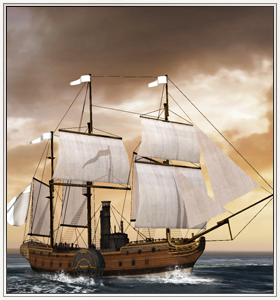Steamship (ETW unit)
| Steamship | ||||
|---|---|---|---|---|

| ||||
| Faction: | |
|
| |
| Range: | 500 | 500 | 500 | 500 |
| Accuracy: | 60 | 70 | 60 | 60 |
| Reloading skill: | 40 | 40 | 55 | 50 |
| Hull strength: | 2976 | 3022 | 3134 | 3134 |
| Speed: | 18 | 19 | 18 | 18 |
| Maneuverability: | High | High | High | High |
| Morale: | 9 | 9 | 10 | 10 |
| Turns to build: | 2 | 2 | 2 | 2 |
| Recruitment cost: | 1740 | 1890 | 1770 | 1720 |
| Upkeep cost: | 430 | 470 | 440 | 430 |
| Requires | ||||
| Building | ||||
| Steam Drydock | ||||
A steamship still uses sails, but the ability to ignore the wind is highly desirable in a warship.
By fitting a steam engine and all its machinery into an existing hull, naval architects hoped to create a ship-of-the-line not tied to the wind and tide. In this, they were moderately successful. A steamship can sail independently of the prevailing winds, but most still spend a good deal of time under sail. Coal is expensive, and coaling stations are few and far between; steam is not a practical method of strategic movement.
Tactically, however, it is a different story. With powerful guns, a steamship can out-manoeuvre any sailing ship. Admittedly, the idea of going into battle with a fire raging in the belly of his ship is not one that appeals to every captain. Boiler explosions are not entirely unknown either, as safety features are installed as the fancy takes the engineer, not as a matter of course. A stray shot through the engine room can also do terrible damage.
Historically, The conversion of ships of the line to steam was never going to be anything more than a stopgap measure. Steamships, with their dirt and smoke, were not popular with traditionally minded captains, particularly in the British Royal Navy. They expected obsessively high standards of neatness and cleanliness, with no soot and lubricating oil smeared over their nice clean ships.
Available for:
| |
|
|
|
|
|
| |
|
|
|
